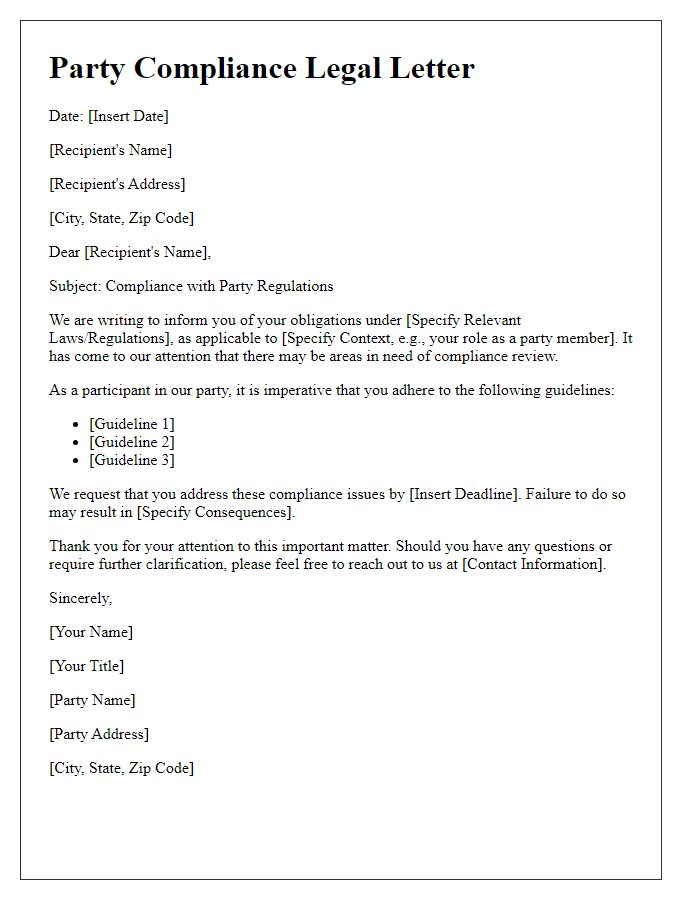Are you looking to enhance your intraparty legal correspondence? Crafting a clear and effective letter can make all the difference in navigating legal matters within a party. In this article, we'll explore essential components and helpful templates to ensure your communication is not only professional but also resonates with your unique context. Dive in to discover valuable insights that will streamline your legal communications!

Salutation and formal greeting
Intraparty legal correspondence often begins with a formal greeting to establish a respectful tone. A commonly accepted salutation in such documents includes "Dear [Recipient's Name]," where the recipient's name can be replaced with their title, such as "Mr.," "Ms.," or their professional designation (e.g., "Attorney Smith"). Following the greeting, a courteous opening statement acknowledges the recipient's involvement in the matter, indicating the purpose of the correspondence and fostering a productive dialogue. This structured approach helps maintain professionalism and clarity in legal communications within a party.
Clear subject and purpose of the letter
In the context of intraparty legal correspondence, a well-defined subject and purpose are crucial for clarity. Clearly stating the main topic, such as "Request for Legal Opinion on Internal Protocol Compliance," establishes the focus of communication. This subject can relate to specific events or instances within the organization, like "Discussion of the Recent Policy Changes from July 2023." The purpose should be succinct yet detailed, explaining the need for legal advice or clarification related to internal party operations, legal compliance, or potential disputes. This immediate identification of the correspondence's intent enhances understanding and expedites the legal review process, facilitating informed decision-making among party members.
Concise explanation of legal issues involved
Intraparty legal correspondence often involves complex legal issues that require clear articulation. Key concerns may include compliance with statutory obligations, interpretation of contractual terms, or adherence to regulatory guidelines. For example, an analysis of the liability clauses within a partnership agreement can reveal potential exposure to financial risks based on specific actions or omissions by individual members. Additionally, disputes regarding intellectual property ownership may arise, necessitating a thorough understanding of copyright and trademark laws, especially in collaborative projects. Critical timelines for filing claims or responses, informed by statutes of limitations, must also be highlighted to ensure legal protections are not compromised. Understanding these issues is essential for making informed decisions within the party structure.
Reference to relevant laws or party regulations
Intraparty legal correspondence must adhere to established party regulations and relevant statutes, reflecting compliance with governance structures. For instance, Article 5 of the Internal Rules of [Party Name], outlines procedures for dispute resolution among members, ensuring fairness and transparency. State law [State Code Section] mandates that all party communications maintain ethical standards, establishing clear parameters for acceptable conduct. Effective referencing of such regulations can strengthen claims and delineate responsibilities, providing a robust legal foundation for the correspondence. Additionally, referencing past adjudications (e.g., [Significant Case Name, Year]) can illustrate precedents that support the legal position taken within the letter.
Closing statement with call to action or response request
Intraparty legal correspondence often requires clarity and precision to ensure effective communication between parties involved. A closing statement in such documents can reinforce the main points discussed throughout the correspondence, providing a succinct summary of key issues. It is crucial to reiterate any requests made, ensuring the recipient understands the next steps required for resolution. Drawing attention to specific deadlines can motivate prompt responses and encourage decisive action. Incorporating phrases like "We await your prompt response" or "Please confirm by [specific date]" can enhance the call to action, emphasizing the importance of timely communication in legal matters, while maintaining professionalism throughout the correspondence.













Comments